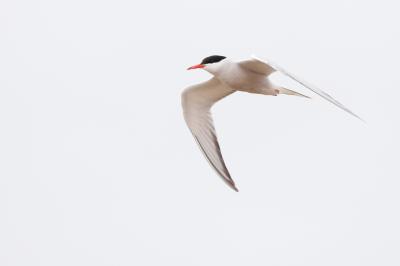Bird of the Month: Common Tern
Anything but common
Swift and graceful flyers, Common Terns are a delight to watch as they skim over the waters of Presque Isle or hover, then dive for a fish dinner.
These fast flyers can often be mistaken for gulls if one doesn't have a keen eye. They, like gulls, have predominantly white or gray bodies, but if examined more closely, their crisp black caps and bright orange-red bills and legs set them apart from the more plentiful Ring-billed and American Herring Gulls that inhabit the park. They look smaller too, with a wing span of approximately 30 inches (Gull wingspans are 48-58 inches). Two features that also set them apart are their forked tails which are easy to see when they fly, and wings tips that are more pointed than gulls.
Their name suggests that these birds are, well, common, or abundant. Common Terns are indeed the most widespread tern species in North America, but the species' conservation status is "common but in steep decline." Here in Pennsylvania, that status is even more fragile as Common Terns are listed as endangered, since the only area in the state that has appropriate habitat for nesting is Presque Isle State Park.
And, indeed, this species is emblematic in the creation of the conservation movement. In the late 19th century, many wading and sea birds – including the Common Tern – were hunted for their feathers to use in women's hats. Since Common Terns were small birds, often the entire bird ended up on hats, becoming a distinctive symbol for conservation advocates.
Common Terns regularly nested at Presque Isle in the past. In the 1930s, a colony of more than 125 nests stretched a quarter mile on the eastern end of the park, according to an account in the book Birds of Western Pennsylvania by Clyde Todd. Unfortunately, there are also accounts of people walking through the colony and scaring away nesting birds and crushing eggs as they went.
Increases in the recreational use of Presque Isle only compounded the problem and terns did not nest again until the past decade and a half. In 2015, a high count of eight nests had everyone hopeful, but all nests failed due to predation or high water.
In 2022, a milestone was reached when a pair of terns successfully reached hatch. Seeing tern chicks toddling around at Gull Point made me and other birders giddy with delight.
That delight did not last long, though, as an unknown predator gobbled those chicks within a few days.
In 2024, the same predation occurred, but the tern adults decided to try again. For this nest, the PA Game Commission designed an exclosure to protect the nest and newly hatched chicks. On Aug. 17, two juvenile terns fledged from that protection and flew free – the first Common Terns to fledge at Presque Isle in more than a half century.
If you want to see one, the best place to look is Presque Isle at Leo's Landing or at Gull Point. Be sure to listen for their strident "keeyurr" flight call then look up. Watching these graceful flyers buoys my soul and makes me grateful for those early conservationists who fought so hard to make it possible for us to still have these birds in our midst.
Mary Birdsong is the lead shorebird monitor for Erie Bird Observatory. Learn more at eriebirdobservatory.org or on their social media channels. She can be reached at mbirdsong@eriereader.com




